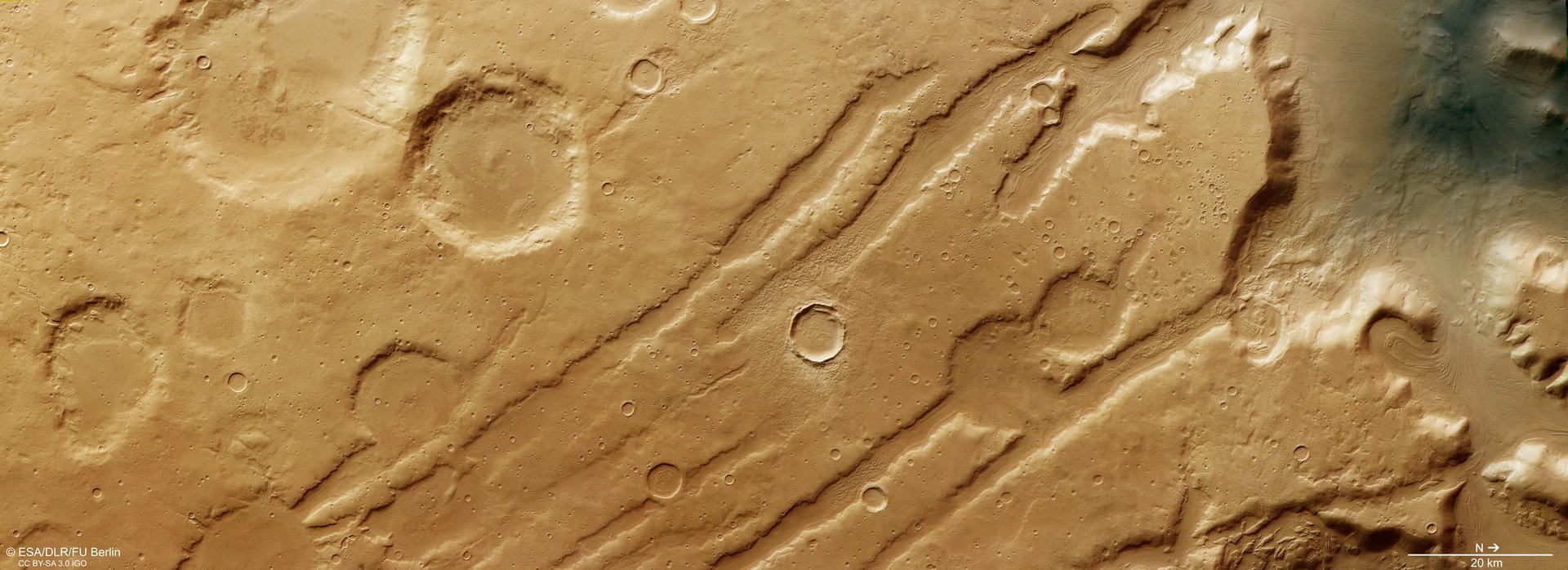Science
Scientists Chart Mars’ Ancient Ice Ages Using New Orbital Images

Recent discoveries from the European Space Agency (ESA) have unveiled significant insights into Mars’ climatic history, revealing patterns indicative of ancient ice ages on the planet. Using the High Resolution Stereo Camera aboard the ESA’s Mars Express orbiter, scientists have captured detailed images of the Coloe Fossae, a system of intersecting canyons located in the Ismenius Lacus quadrangle. These images provide compelling evidence of past ice flows that have shaped the Martian landscape.
The geological record suggests that Earth has experienced multiple ice ages over the past 2.5 billion years, with the last major glacial period occurring during the Pleistocene epoch, roughly from 2.58 million to 11,700 years ago. This era is known for its dramatic climate shifts, which have been documented both through physical evidence and Indigenous oral traditions. Similarly, Mars exhibits signs of extensive glacial activity, influenced by long-term variations in its axial tilt, or obliquity.
The newly obtained images reveal lineated valley fill (LVF) and concentric crater fill (CCF) features on the floors of the canyons and craters. These patterns are formed from rocky materials deposited by ice flows that advanced and retreated across the region. On Earth, comparable features result from glaciers leaving behind till—a mixture of clay, silt, sand, and gravel—creating ridges and elongated mounds.
Interestingly, the Coloe Fossae region is situated far from Mars’ northern polar ice cap, suggesting that glaciers once extended into this area. Researchers believe that, similar to Earth’s glacial periods, Martian glaciers advanced from the poles towards the mid-latitudes during colder cycles, only to retreat during warmer interglacial periods. This finding has significant implications, as it indicates that Martian glacial activity was widespread, occurring across various mid-latitude regions.
Understanding the movement of ice across Mars is crucial for reconstructing the planet’s geological and environmental history. Scientists aim to piece together how Mars transitioned from a warmer, wetter environment to the cold, arid world observed today. The patterns captured in the ESA images may hold the key to answering pivotal questions about the planet’s past climate and its potential for habitability.
For those interested in examining the detailed images, an annotated version is available, highlighting the LVF features for closer inspection. This ongoing research not only enhances our understanding of Mars but also provides valuable insights into the broader dynamics of planetary climate systems.
Further Reading: ESA
-

 Technology4 months ago
Technology4 months agoDiscover the Top 10 Calorie Counting Apps of 2025
-

 Health2 months ago
Health2 months agoBella Hadid Shares Health Update After Treatment for Lyme Disease
-

 Health3 months ago
Health3 months agoErin Bates Shares Recovery Update Following Sepsis Complications
-

 Technology3 weeks ago
Technology3 weeks agoDiscover 2025’s Top GPUs for Exceptional 4K Gaming Performance
-

 Technology4 months ago
Technology4 months agoDiscover How to Reverse Image Search Using ChatGPT Effortlessly
-

 Technology2 months ago
Technology2 months agoElectric Moto Influencer Surronster Arrested in Tijuana
-

 Technology4 months ago
Technology4 months agoMeta Initiates $60B AI Data Center Expansion, Starting in Ohio
-

 Technology4 months ago
Technology4 months agoRecovering a Suspended TikTok Account: A Step-by-Step Guide
-

 Health4 months ago
Health4 months agoTested: Rab Firewall Mountain Jacket Survives Harsh Conditions
-

 Lifestyle4 months ago
Lifestyle4 months agoBelton Family Reunites After Daughter Survives Hill Country Floods
-

 Technology3 months ago
Technology3 months agoUncovering the Top Five Most Challenging Motorcycles to Ride
-

 Technology4 weeks ago
Technology4 weeks agoDiscover the Best Wireless Earbuds for Every Lifestyle




















